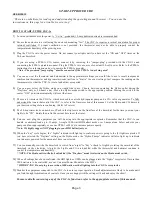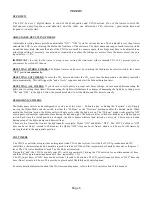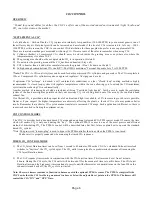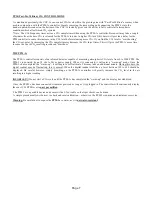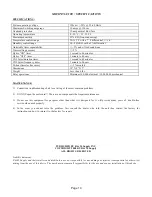
Page 6
CO2 CONTROL
OVERVIEW
“Pound for pound, dollar for dollar, the CGC-1e offers one of the most advanced environmental / light / hydro and
CO
2
control system on the market”.
“SUPPLEMENTAL CO
2
”
Let's talk about ... Carbon Dioxide. CO
2
is present in relatively low quantities, (300-600 PPM) in your normal, generic, run of
the mill everyday air. But plant growth can be increased and accelerated if the level of CO
2
is increased to, let’s say... 1000 -
1500 PPM. For this reason, the CGC-1e can control CO
2
distribution for those people who prefer to use supplemental CO
2
.
There are some inherent dangers associated with using CO
2
. Here are some of the rules to remember when using CO
2
:
A)
Cylinders (bottles) of compressed CO
2
should never be stored inside the growing area or anywhere else where the
temperature may rise above 100’f.
B)
The growing area should not be occupied while CO
2
is in operation. (Get out!)
C)
Do not enter the growing area until the CO
2
has been exhausted. (Stay out!)
D)
CO2 is heavier than air and will accumulate towards the ground. (Don’t lie down on the job!)
E)
In high enough concentrations CO
2
can kill!!! The OSHA maximum “Personal Exposure Level” is 5000 PPM.
*Note:
The CGC-1e CO
2
control system can be used for both compressed CO
2
cylinders, and generators. The CO
2
receptacle is
120vac. Compressed CO
2
cylinders require an approved regulator / flow gage and a valve.
If optimum CO
2
“mileage” is desired, a self contained air conditioner or other “Closed loop” cooling method is highly
recommended. A closed loop system will regulate temperatures within the zone allowing you to extend the CO
2
maximum
cycle time thus reducing CO
2
use dramatically.
Another method of reducing heat build up includes utilizing “Ventilated light hoods”. Just be sure to make the ventilation
system of the hood as airtight as possible so that your precious CO
2
is not being drawn out of the area by the ventilated hood
exhaust fan.
If sufficient CO
2
is provided and the proper level of nutrients and light is available, a 35% increase in growth rate is possible.
However if you suspect the higher temperatures are adversely affecting the plants, a shorter CO
2
cycle may produce better
results. Remember that a shorter CO
2
cycle duration translates to increased CO
2
usage. Each application is different, so there is
some work involved in finding the optimum set-up.
CO2 CONTROL MODES
The CGC-1e provides both a standard timed CO
2
mode and an optional integrated CO
2
PPM control mode. Of course, the time
clock will ensure CO
2
is only used during the “day”. The optional PPM-1c sensor is one of the most precise and efficient
method of distributing CO
2
. The PPM-1c control will be described later, but first, let me explain how to operate the standard
timed CO
2
system.
*Note: The pre-wired “jumper-plug” is used to bypass the PPM controller functions when the PPM-1c is not used.
Make sure it is properly connected when running the timed CO
2
sequence.
TIMED CO
2
CONTROL MODE
1)
The CO
2
Inject Duration timer can be set from 1 second to 40 minutes. When the CGC-1e’s standard 24-hour timeclock
switches to “daytime”, the CO
2
cycle begins. The CO
2
outlet is energized for a predetermined amount of time using the
CO
2
Inject Duration timer.
2)
The CO
2
Frequency timer works in conjunction with the CO
2
Injection timer. This timer can be set from 1 minute -
8 hours. During the CO
2
cycle, the CO
2
outlet will be turned off for the amount of time set on this timer. The CO
2
Inject
Duration timer and the Frequency timer continue to recycle until the thermostat or humistat turns on the fans. When the
exhaust is turned back off, the CO
2
cycle is re-started.
Note: These two timers continue to function in harmony with the optional PPM-1c sensor. The PPM-1c simply tells the
CGC-1e whether the CO
2
level being measured is above or below the adjustable set point on the PPM-1c. The timers still
control the CO
2
“ON” and “OFF” time.



